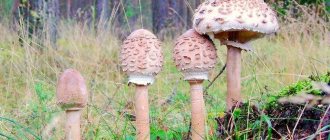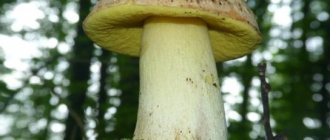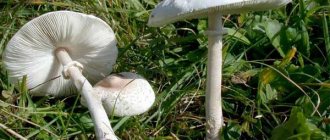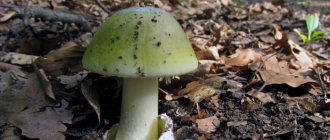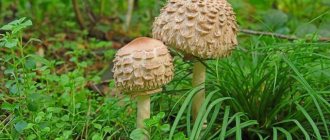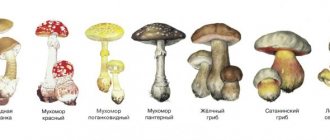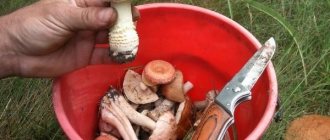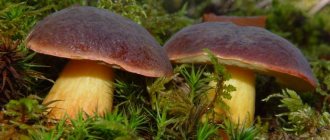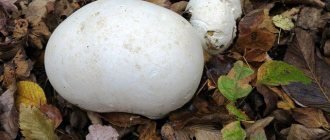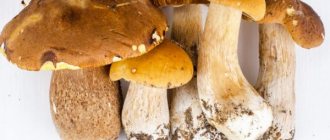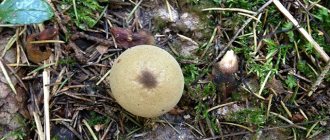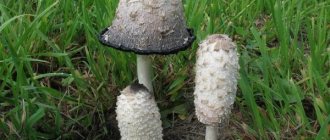From our article you will find out whether the umbrella mushroom is edible, get acquainted with its varieties, and also learn where to collect it and how to process it correctly.
Each of us at least once in our lives has seen on the edges of the forest, in groves, in mixed deciduous forests, a mushroom somewhat reminiscent of a pale toadstool. Most people just bypass it and never put it in their wallet. But as practice shows, in most cases people come across a very tasty and healthy umbrella mushroom.
Yes, it also has poisonous counterparts that are unsuitable for food, but if you know how to distinguish these two types of mushrooms, then you can safely collect umbrellas and cook delicious dishes from them. In our article we will introduce you to edible and poisonous types of umbrellas, and also teach you how to accurately distinguish them.
What is the correct name for an edible umbrella mushroom?
Scientific name of the umbrella mushroom
This forest dweller received such an interesting name because of the characteristic structure of its cap. Visually, it very much resembles an open umbrella. That is why people who regularly pick mushrooms began to call it an umbrella. In fact, in the scientific community this mushroom has a completely different name. As a rule, scientists call the umbrella mushroom humus saprotroph . Or to be more precise, a saprotrophic fungus that feeds on organic residues decomposing in the ground.
IMPORTANT: Due to the fact that the umbrella mushroom, like a sponge, absorbs absolutely all substances from the soil, it is advisable to collect it in ecologically clean areas, and as far as possible from busy highways and industrial enterprises. If you collect such mushrooms in a place contaminated with chemicals, then with a high probability we can say that even an edible species will provoke poisoning of the body.
Growing at home and in the garden
The variegated umbrella is very popular among mushroom pickers, and therefore it is often grown at home in a country house or garden plot. You can buy mycelium in a specialized store, and it will be enough to sow 3 square meters. m. area.
- For cultivation, you should choose partial shade, best under trees or shrubs; you can plant them in a raspberry field or between strawberry beds. The shady sides of outbuildings and fences, where there is no direct sunlight, are suitable.
- The soil needs to be fluffed up, but it is better not to remove the grass if it does not interfere with other plants. Distribute the mycelium over the surface, and scatter 10 cm of humus on top. After 5 months, the first fruits will appear.
- The harvest can be harvested from early spring to late autumn. Planting is best done in autumn or spring. There is no need to insulate for the winter, the spores will not die. Every year you should pour a layer of humus onto the mycelium; it is better to do this before winter. It will be possible to collect umbrellas for 6 years.
Edible umbrella mushroom: what does it look like, what can it be confused with?
Edible umbrella mushroom
As mentioned a little above, the umbrella mushroom has one distinctive feature that allows it to stand out from its relatives. An adult mushroom has a cap that resembles an umbrella. Under favorable conditions, its diameter can reach 35 centimeters. The length of the leg can also vary from 5 to 45 centimeters. As a rule, the larger the diameter of the mushroom cap, the longer and thicker its stem.
The cap of the umbrella mushroom is covered with peculiar scales and is dry to the touch. If the mushroom grows very strongly, the skin on the cap begins to crack and a translucent fringe forms. The stem of the umbrella is slightly thickened at the base of the soil and has a characteristic movable ring.
The flesh of the mushroom is light in color; when crushed, it begins to release clear, pleasant-smelling juice. But only adult mushrooms look this way. If you find a young umbrella, it will look like a small egg on a thin stalk. True, it will have the same color, and there will also be scales on the cap.
Most often, this type of mushroom is confused with its poisonous counterparts or with pale toadstools. This is due to the fact that poisonous mushrooms can visually look like umbrellas - have a similar color, size and shape of the cap. But there are still differences between these types. We will tell you a little about them below.
Umbrella mushrooms - edible: varieties, description, photo
As you already understand, not all umbrella mushrooms are edible. Among this species there are also poisonous representatives that can harm the human body. That is why now we will introduce you to edible types of umbrellas. They can be easily collected throughout the mushroom season and consumed after heat treatment.
Types of edible umbrella mushrooms:
White. This species has another name - field. It is called that because of its color and place of growth. As you probably already understood, its flesh is light in color. It can be white, cream or light gray. Initially, this species has an ovoid cap, which over time opens up and becomes like an umbrella. Most often found in meadows, fields and open forest edges.
Motley. This type of umbrella, as a rule, is quite large in size. The mushroom cap is completely dry and covered with characteristic brown scales. Small dark brown growths are also clearly visible on the cap. That is why this type of umbrella has a darker shade than other relatives. The flesh of the motley umbrella is cotton-like, with a pronounced nutty odor. Likes to grow in open, well-lit areas.
Blushing . The cap of this type of umbrella has a gray or brownish tint and a thin, almost white stem, which, as the mushroom grows, darkens and thickens at the base of the soil. The mushroom got its name due to the ability of the pulp to oxidize. If you break the umbrella cap, droplets of juice will appear on it almost immediately, which very quickly turns from transparent to reddish-brown. In addition, the red umbrella has more developed scales. Since visually they resemble a kind of fringe, sometimes a blushing umbrella is called shaggy. For growth, it selects soil that is rich in nutrients.
Maiden. This type of umbrella is listed in the Red Book, so it is almost impossible to find it in our forests. The mushroom differs from its relatives in that it does not grow to large sizes. As a rule, the cap, even in adult representatives, has a diameter of no more than 10 cm. The girl's umbrella has a light shade of flesh and a not very pronounced mushroom aroma.
IMPORTANT: Edible umbrellas also include mastoid umbrella . In terms of taste, it is practically no different from its relatives, but only its cap is considered edible. The stem of this species is very bitter. In view of this, it is better not to eat it. Therefore, if you collect these particular umbrellas, then immediately remove the stem.
Mastoid. It has a matte light brown cap, the edges of which are lowered down. During the dry period, the skin on the cap begins to crack and a peculiar pattern is formed on it. The main difference between the mastoid umbrella and other relatives is the presence of a pronounced tubercle in the very center of the cap. Visually, it resembles a brownish nipple.
Umbrella mushrooms - poisonous: varieties, description, photo
Well, now let's look at the types of poisonous umbrellas. You need to know them, because if you cannot distinguish them from edible ones, you will bring home a poisonous mushroom that will cause great harm to your body.
Types of poisonous umbrella mushrooms:
Comb. It has a light brown cap with a diameter of up to 5 centimeters. The entire surface of the cap is covered with brownish-orange scales. It has a thin leg up to 10 centimeters long. The stem is empty inside and has a pink and white ring. In addition, this type of umbrella has a rather unpleasant odor.
Chestnut. This type of umbrella is also called chestnut leotype. It has a small cap, which initially resembles an umbrella, but as the mushroom grows it completely flattens out. Another feature indicating the toxicity of the umbrella is the presence of concentric rows on the cap. The leg is thickened, but the ring on it may be missing. More precisely, only young mushrooms have it, but as soon as the stem becomes longer and thickens, it immediately disappears.
Chlorophyllum is dark brown. This umbrella double contains a hallucinogenic substance that negatively affects the human nervous system, so it should absolutely not be eaten. Visually, this poisonous mushroom looks like an umbrella, but unlike the latter, it is fleshier and does not have a very high stem. The stem has a tuberous growth that is clearly visible above the surface of the soil. When broken, chlorophyllum immediately turns red.
The fly agaric is smelly. If you think that a fly agaric can only have a red cap, then you are deeply mistaken. In nature, there are fly agarics of different colors. This species is considered very poisonous, so its consumption in 85% leads to death. Visually, the stinking fly agaric is very similar to a young umbrella. Therefore, inexperienced mushroom pickers very often confuse them and put it in their wallet. But if you look closely at it, you can see that it does not have the characteristic scales on its cap, and there is also an unpleasant chlorine smell.
Reviews + photos
- Elena, 39 years old
It’s a pity that I didn’t know about the edibility of this mushroom before. It's incredibly delicious! Now I’m trying to collect as many Motley Umbrellas as possible in the Moscow region.
- Valentina, 49 years old
Last year I scored 10 buckets in one outing. Looking forward to the opening of the season in 2022! I really hope to break my record.
- Egor Viktorovich, 57 years old
I cook Pops only with butter. It gives mushrooms a delicate taste and divine aroma. But I don’t recommend cooking with olive and sunflower oil - it smells like burnt oil.
- Marina Igorevna, 24 years old
I always cook umbrellas with herbs and eggs. It turns out to be a dish immediately with a side dish, and much less time is spent!
- Polina Eduardovna, 69 years old
Come to the Voronezh region to pick mushrooms! Here you will find not only umbrellas, but also boletus, porcini and even Polish mushrooms.
How to distinguish an umbrella mushroom from a fly agaric, toadstool, poisonous mushrooms: comparison, similarities and differences
The main signs of poisonous mushrooms
If you carefully read our article, you probably realized that an umbrella mushroom can very easily be confused with a poisonous relative or double. For example, a white umbrella may have the same flesh color as a toadstool. In addition, the cap of poisonous mushrooms has a shape almost the same as an umbrella. Above we have already mentioned the stinking fly agaric, which is visually very similar to a young umbrella.
But unlike the latter, its cap and stem are covered with a not very pleasant-smelling coating . Therefore, if you smell it after cutting a mushroom, you will immediately understand that this is a toadstool. Another difference between mushrooms is the dots on the cap . On an umbrella they are always of a dark shade - dark gray, dark brown, dark beige.
Poisonous mushrooms have white dots, sometimes with a greenish tint. And, of course, do not forget that most poisonous mushrooms have a tuberous formation at the base of the ground or a so-called involucre , which wraps the stem slightly above the soil level. Umbrella mushrooms have a straight stem without growths with a slight thickening at ground level or at the base of the cap. This feature depends on the type of umbrella.
How to distinguish an umbrella mushroom from a champignon?
Differences between umbrella mushrooms and champignons
In principle, anyone can distinguish an umbrella mushroom from an ordinary champignon. We most often see this type of champignon on store shelves, so there shouldn’t be any difficulties. Most often, this champignon chooses meadows, fields, gardens and even vegetable gardens for growth. It has white flesh and a hemispherical cap. The edges of the cap are connected to the stem with a white film. As you can see, visually the champignon is very different from the umbrella mushroom.
True, we must take into account that there are two more types of champignons - forest and field. They are visually more similar to an umbrella mushroom. They have a more spread-out cap with a barely noticeable tubercle in the very center. Perhaps the most noticeable difference between these two forest dwellers is the color and smell of the pulp. As for the smell of champignons, as a rule, it is almond-like. The color is also initially white, but if you cut the mushroom, it will begin to turn pink, and then the cut will become reddish or grayish.
How to cook?
There are a large number of ways to prepare umbrella mushrooms. These include:
Frying. A hat works very well for this type of cooking. It contains the most pulp, so the dish will turn out tender, and most importantly tasty.
Cooking. And for this method, hard legs are best suited. During the cooking process they will soften and give the dish a special mushroom flavor and aroma.
Drying and grinding. Mushroom stems are also best suited for this. They can be dried and then crushed by grinding or grinding.
The resulting mass (powder) can be used as a seasoning for other ready-made dishes. This seasoning will give dishes a special, spicy flavor of mushrooms.
Decorating food. Raw umbrellas of this forest dweller can be used to decorate dishes, giving them a sophisticated look. This way you can decorate sandwiches, salads and snacks.
Are umbrella mushrooms good for you?
The benefits of mushrooms for the human body
Surely you have heard that mushrooms can benefit the human body. Provided, of course, that they are edible and collected in the right place. In view of this, we can confidently say that an umbrella, when used correctly, can improve your well-being. It contains substances that have a weak antitumor effect , thereby inhibiting the development of benign tumors.
In addition, these substances have a positive effect on the body's cells, helping them to renew themselves regularly and do so correctly. Umbrella mushrooms also have a positive effect on hematopoiesis and the functioning of the cardiovascular system . And, of course, do not forget that all mushrooms have a very low glycemic index . Therefore, if you want to lose weight, be sure to include this product in your diet.
Can there be poisoning from umbrella mushrooms?
Poisoning with umbrella mushrooms
Poisoning with umbrella mushrooms can occur in several cases. So, if you collect double mushrooms or poisonous fly agaric mushrooms, you will definitely get poisoned. Therefore, when going on a quiet hunt, try to inspect each mushroom as carefully as possible. Look closely at its color, smell it, if you suspect, break it and look at the juice. All this will help you avoid further problems.
You can also be poisoned by edible mushrooms. If they are collected in an environmentally polluted place, the toxic substances they contain will begin to negatively affect the gastrointestinal tract and the person will show all the symptoms of poisoning. Problems with the gastrointestinal tract can also arise if you eat too many umbrella mushrooms. Since they contain substances that slow down the production of gastric juice, excessive consumption of this product can cause diarrhea, nausea and vomiting.
Cooking recipes
There are a lot of delicious and healthy recipes, the ingredients of which will be umbrella mushroom.
Breaded mushrooms
- You will need 500 g of mushrooms.
- Two eggs.
- Onions 2 pieces.
- Three tablespoons of flour.
- Hard cheese 300 g.
- A little vegetable oil, salt, ground black pepper.
- A bunch of parsley and dill.
First, prepare the mushrooms. Remove the stems and clean and rinse the caps well.
Beat eggs and flour until smooth. Season well with salt and pepper. Finely chop the onion.
Place mushrooms on a baking sheet and sprinkle with onions. Pour flour and eggs on top. Sprinkle with hard cheese and then place in the oven for 30 minutes at 200 degrees. Wait for the cheese to melt. Stewed mushrooms need to be decorated with herbs.
Mushroom caviar
When prepared correctly, caviar turns out to be very tasty. To prepare it you will need:
- 1 kg of mushrooms;
- 4 onions;
- vegetable oil;
- lemon juice in the amount of 40 ml;
- garlic;
- salt;
- sour cream 100 ml;
- 2 tablespoons of tomato paste.
Peel the mushrooms, finely chop the onion and fry in a frying pan.
Then add the mushrooms to the frying pan and fry until the onions acquire a golden hue. After this, add sour cream and simmer for about 10 minutes over low heat. Mix everything well, add salt, pepper and other favorite spices.
Simmer for 20 minutes. Season the resulting caviar with tomato paste in the specified amount. Serve spread on baguette or toast.
Umbrella mushrooms in the microwave
If you are hungry, umbrella mushrooms can be cooked very quickly in the microwave.
- To do this, separate the caps from the legs. You don't need legs.
- Add 200 ml mayonnaise.
- Season with black pepper and salt.
- Add coriander and a pinch of nutmeg.
- Mushrooms must be pre-prepared and marinated in the specified mixture. Leave for 30 minutes.
- Later, place the mushrooms on a plate, cover with a lid and microwave for 15 minutes.
The dish must be hot when served. It is recommended to decorate it with dill and parsley.
Umbrella stuffing
The French love to use this mushroom as a filling for buns, croissants or pancakes. But in order to prepare a truly delicious filling, you need to follow the recipe.
You will need 500 g of mushrooms.
- They need to be washed and cleaned well.
- The stem is separated from the cap.
- All mushrooms must be finely chopped with a knife to obtain a brown mass.
- Finely chop onion, garlic, and herbs. It is recommended to use basil, parsley, dill, and oregano.
- All ingredients are prepared. Place the frying pan on the fire, heat the vegetable oil.
- First, add the onion. Fry it until golden brown.
- Next, add the mushrooms. Fry together with the onion for a short time, just a couple of minutes.
- Then add finely chopped herbs and garlic.
- Fry everything together for a few more minutes.
- Then take heavy cream. Carefully pour in approximately 80 ml.
- Continue stirring the resulting mass.
- Then, add some dry white wine. Approximately 30-40 ml.
- Continue to simmer. At the very end, add salt and pepper to taste, as well as other favorite seasonings.
Before adding the filling to pancakes or buns, it must be well cooled.
The cool filling will have a slightly nutty aroma and goes well with the airy yeast dough.
If you want to stuff pancakes, you can add fried minced chicken to this mixture. It turns out very tasty, and most importantly, interesting. New line with
Cream can be replaced with full-fat sour cream. It is possible to achieve the same effect.
Where and when to collect umbrella mushrooms?
The umbrella mushroom grows in coniferous, deciduous and mixed forests.
As you probably already understood, you can find an umbrella mushroom absolutely everywhere. Since this mushroom is not particularly whimsical, it thrives wherever there are favorable conditions for it. For abundant fruiting, it needs enough moisture and light. In view of this, for growth it chooses sunny areas with a moderate amount of moisture. Depending on the species, it can grow either singly or in large groups.
You can find the umbrella mushroom in deciduous, coniferous and mixed forests . The first young mushrooms appear at the end of May, beginning of June . The season for collecting umbrellas ends at the end of September, mid-October . As a rule, at the end of October, umbrellas disappear because for their normal growth, in addition to moisture and light, they also need warmth. That is why, even during cold periods in summer, you can observe a sharp decrease in the number of this type of fungus.
Time and place of fruiting
The variegated umbrella is a saprotroph and prefers sandy soils, light areas, clearings and forest edges. It can often be found in clearings and clearings, as well as in parks, on the grass, in the garden and in the field.
It is most widespread in the north of the temperate zone. It is most often found in Europe, Turkey, Iran, Kyrgyzstan and Mongolia. Distributed in Siberia and the Far East.
Can be found in Japan, North and South America, Australia. Even on islands such as Cuba, Madagascar and Sri Lanka, this mushroom is collected.
Fruiting time occurs from June to November, often found singly, sometimes in small groups that form “witch circles.”
Video
How to process umbrella mushrooms?
Rules for processing umbrella mushrooms
In principle, processing umbrella mushrooms is the same as any other. At the initial stage, you just need to clear them of dry grass, leaves and soil. Since the umbrella cap is dry and not very sticky, you can handle this task easily. Next, you will need to clear the leg of the soil and cut it off immediately. As a rule, the stems and caps of these mushrooms are boiled separately.
This is due to the fact that in some species they produce bitterness, which can spoil the taste of the finished dish. If you are sure that you do not have such umbrellas, you can buy both the hats and the legs together. After you deal with the legs, you can begin to remove the scaly film from the cap. At the final stage, all that remains is to rinse the mushrooms in plenty of water and you can boil, fry or dry them.
Benefits for the body
Large lepiota has excellent taste. That is why many mushroom pickers purposefully go for it. It is better to collect and use mushrooms when they are young. Only in this case they contain a huge amount of vitamins and nutrients. They are preserved even after heat treatment. The properties are preserved after marinade, salting and drying.
What substances does the umbrella mushroom contain?
- B vitamins.
- Vitamin C.
- Vitamin E.
- Vitamin K
- Tyrosine.
- Beta glucans.
- Potassium.
- Calcium.
- Magnesium.
- Phosphorus.
- Iron.
- Sodium.
- Melanin.
That is why, in ancient times, local healers actively used lepiota majora to prepare tinctures and extracts in order to eliminate serious ailments. Indeed, the mushroom helps fight the following types of diseases:
- oncology;
- rheumatism;
- diseases of the heart and blood vessels;
- various nervous system disorders.
How to use mushroom to benefit your health?
Yes, this is what you need to know, how to make a tincture recipe.
It can be used in the treatment of diseases, as well as for general strengthening of the body and boosting immunity.
For cooking you will need 700 g of mushrooms.
- They need to be washed well, dried and finely chopped.
- Then take 500 ml of vodka.
- Pour liquid over mushrooms.
- If necessary, add a few small capsicums.
- Store the tincture in a cool, dark place for 2-3 weeks.
- After this time, it can be actively used.
For example, do rubbing, massage, and also add to food.
Of course, such treatment methods can only be carried out if you are sure that such therapy is not contraindicated for you.
Might be interesting - Dung beetle mushroom (Coprinus): description of 6 species with photos, an effective remedy for alcoholism.
Umbrella mushroom, pop - the largest: what does it look like?
Umbrella mushroom, pop
Umbrella mushroom, pop is a large umbrella mushroom with dense but juicy flesh with a pleasant aroma. This species is considered edible, although you must remember that the older the umbrella is, the rougher and less juicy its flesh will be. Visually, the umbrella pop is practically no different from its relatives from the Champignon family. It also has light flesh with a gray or beige tint, a straight leg and characteristic scales on the cap.
But the shape of the hat itself is slightly different. In young mushrooms it also has the shape of an umbrella, but as soon as the mushroom reaches its maturity, it becomes like a saucer with a small bulge in the very center. Some differences also apply to the legs. Initially it has a brownish color, but the older the umbrella gets, the more it turns brown and small dark-colored scales appear on it.
Edible or not?
In Russia, the mushroom belongs to the category of edible expensive mushrooms. It is used for preparing first and second courses, snacks, drying and even preparations for the winter. The cap is used for frying, freezing and canning, the leg is used for drying.
In the West, only the cap is considered edible. This is due to the fact that the leg cooks many times faster than the leg. Of course, the prejudice is quite funny and it won’t be difficult to challenge it, but as they say, “There are no comrades according to taste!”
